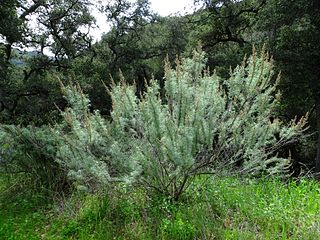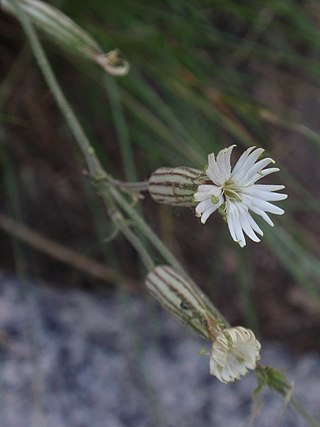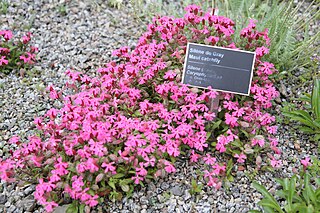
Silene dioica, known as red campion and red catchfly, is a herbaceous flowering plant in the family Caryophyllaceae, native to Europe and introduced to the Americas.

Adenostoma fasciculatum, commonly known as chamise or greasewood, is a flowering plant native to California and Baja California. This shrub is one of the most widespread plants of the California chaparral ecoregion. Chamise produces a specialized lignotuber underground and at the base of the stem, known as a burl, that allow it to resprout after fire has off burned its stems. It is noted for its greasy, resinous foliage, and its status as one of California's most iconic chaparral shrubs.

Artemisia californica, also known as California sagebrush, is a species of western North American shrub in the sunflower family.

Rhus ovata, commonly known as sugar bush or sugar sumac, is a shrub or small tree found growing in the canyons and slopes of the chaparral and related ecosystems in Southern California, Arizona, Baja California and Baja California Sur. It is a long lived-plant, up to 100 years, and has dense evergreen foliage that make it conspicuous. It is closely related to and hybridizes with the lemonade sumac.

Prunus ilicifolia is native to the chaparral areas of coastal California, Baja California, and Baja California Sur. as well as the desert chaparral areas of the Mojave desert.

Papaver californicum is a species of poppy known by the common names fire poppy and western poppy.

Astragalus brauntonii is a rare species of milkvetch known by the common name Braunton's milkvetch. It is endemic to California, where it is known from fewer than 20 extant occurrences in the hills and mountains surrounding the Los Angeles Basin in Southern California. This is a federally listed endangered species in the United States.

Xylococcus is a monotypic genus of flowering plants in the heather family which contains the single species Xylococcus bicolor, commonly known as the mission manzanita. It is a burl-forming, evergreen shrub to tree with leathery leaves and smooth dark reddish bark. From December to February, white to pink urn-shaped flowers adorn the foliage, often attracting hummingbird pollinators. It is native to southern California and the Baja California Peninsula, south to the Sierra de la Giganta. There is growing concern over the future of this plant, referred to as the "queen of the elfin forest, " as it may possibly lose up to 88% of its habitat and its wild seedlings are failing to survive more than a full year.

Acmispon maritimus, synonym Lotus salsuginosus, is a species of legume native to Arizona, California and northwestern Mexico. It is known by the common name coastal bird's-foot trefoil. It grows in many types of mountain, desert, and scrub habitat, not necessarily near the coast. It is an annual herb quite variable in morphology, from petite to bushy, hairless to roughly hairy, and prostrate to erect in form. The slender stems are lined with leaves each made up of pairs of leaflets variable in shape and size. The inflorescence is a small array of 1 to 4 yellow flowers, each up to a centimeter long or so. The elongated flower corolla emerges from a tubular calyx of sepals. The fruit is a legume pod up to 3 centimeters long. Laboratory studies have shown this species, which occurs in wildfire-prone habitat such as chaparral, to have an increased rate of seed germination after exposure to heat.
Pedicularis howellii is an uncommon species of flowering plant in the family Orobanchaceae known by the common name Howell's lousewort. It is endemic to the Siskiyou Mountains of the Klamath Range in southern Oregon and northern California, where it grows on the edges of coniferous forests. This is a perennial herb producing one or more stems up to 45 centimetres (18 in) tall from a long caudex. The leaves are up to 20 centimetres (8 in) long, lance-shaped, and divided into many toothed oval lobes; those higher on the stem may be unlobed. The basal leaves fall away early. The inflorescence is a small raceme of flowers occupying the top of the stem. Each white to light purple flower is up to one centimetre long and is sickle-shaped, with a curved beak-like upper lip and a three-lobed lower lip which may be tucked into the hairy mass of sepals. The plant is pollinated by bumblebees including Bombus mixtus. Between the flowers are hairy to woolly triangular bracts. The fruit is a capsule just under a centimeter long containing seeds with netted surfaces.
Pediomelum californicum is a species of flowering plant in the legume family known by the common name California Indian breadroot. It is endemic to California, where it grows in the chaparral and woodlands of the coastal mountain ranges. It is a perennial herb with no stem or a short stem that is mostly underground, leaving the plant at ground level. The compound leaves are each made up of five to seven oval leaflets which may be nearly 3 centimetres long. The inflorescence is a raceme of several blue or purple pealike flowers each about one centimetre long. The fruit is a hairy oval beak-tipped legume pod up to one centimetre long containing smooth kidney-shaped seeds.
Silene aperta is a rare species of flowering plant in the family Caryophyllaceae known by the common names naked catchfly and Tulare campion. It is endemic to Tulare County, California, where it is known only from the coniferous forests of the High Sierra Nevada. It is a perennial herb growing from a woody, branching caudex sending up several erect stems up to about 60 centimetres tall. The lower leaves are linear in shape, up to 12 cm long but less than one wide. Leaves higher on the stem are smaller. The flower has a hairy, tubular calyx of fused sepals with ten veins. The calyx is open at the top, revealing five white or yellow-green petals each 1 to 2 cm long.

Silene bernardina is a species of flowering plant in the family Caryophyllaceae known by the common name Palmer's catchfly.
Silene serpentinicola is a rare species of flowering plant in the family Caryophyllaceae known by the common name serpentine Indian pink and serpentine catchfly.

Silene campanulata is a species of flowering plant in the family Caryophyllaceae known by the common names Red Mountain catchfly and bell catchfly. It may be a synonym of Silene greenei.

Silene conoidea is a species of flowering plant in the family Caryophyllaceae known by the common names weed silene and large sand catchfly. It is native to Eurasia, and it is known in other parts of the world, such as western North America, as a weed.

Silene grayi is a North American species of flowering plant in the family Caryophyllaceae, known by the common name Gray's catchfly.

Silene noctiflora is a species of flowering plant in the family Caryophyllaceae known by the common names night-flowering catchfly, nightflowering silene and clammy cockle. It is native to Eurasia, but it is known on other continents as an introduced species and sometimes a weed. In North America, it is a common weed of grain crops in the Canadian prairie provinces and in much of the United States. It grows in fields and in other disturbed habitat.

Silene occidentalis is a species of flowering plant in the family Caryophyllaceae known by the common names western catchfly and western campion.

Silene verecunda is a species of flowering plant in the family Caryophyllaceae known by the common name San Francisco campion.
















